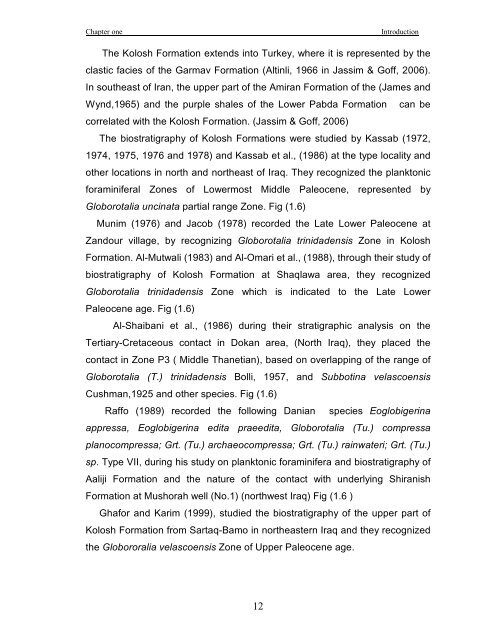biostratigraphy and paleoecology of cretaceous/tertiary boundary in ...
biostratigraphy and paleoecology of cretaceous/tertiary boundary in ...
biostratigraphy and paleoecology of cretaceous/tertiary boundary in ...
Create successful ePaper yourself
Turn your PDF publications into a flip-book with our unique Google optimized e-Paper software.
Chapter one<br />
Introduction<br />
The Kolosh Formation extends <strong>in</strong>to Turkey, where it is represented by the<br />
clastic facies <strong>of</strong> the Garmav Formation (Alt<strong>in</strong>li, 1966 <strong>in</strong> Jassim & G<strong>of</strong>f, 2006).<br />
In southeast <strong>of</strong> Iran, the upper part <strong>of</strong> the Amiran Formation <strong>of</strong> the (James <strong>and</strong><br />
Wynd,1965) <strong>and</strong> the purple shales <strong>of</strong> the Lower Pabda Formation can be<br />
correlated with the Kolosh Formation. (Jassim & G<strong>of</strong>f, 2006)<br />
The <strong>biostratigraphy</strong> <strong>of</strong> Kolosh Formations were studied by Kassab (1972,<br />
1974, 1975, 1976 <strong>and</strong> 1978) <strong>and</strong> Kassab et al., (1986) at the type locality <strong>and</strong><br />
other locations <strong>in</strong> north <strong>and</strong> northeast <strong>of</strong> Iraq. They recognized the planktonic<br />
foram<strong>in</strong>iferal Zones <strong>of</strong> Lowermost Middle Paleocene, represented by<br />
Globorotalia unc<strong>in</strong>ata partial range Zone. Fig (1.6)<br />
Munim (1976) <strong>and</strong> Jacob (1978) recorded the Late Lower Paleocene at<br />
Z<strong>and</strong>our village, by recogniz<strong>in</strong>g Globorotalia tr<strong>in</strong>idadensis Zone <strong>in</strong> Kolosh<br />
Formation. Al-Mutwali (1983) <strong>and</strong> Al-Omari et al., (1988), through their study <strong>of</strong><br />
<strong>biostratigraphy</strong> <strong>of</strong> Kolosh Formation at Shaqlawa area, they recognized<br />
Globorotalia tr<strong>in</strong>idadensis Zone which is <strong>in</strong>dicated to the Late Lower<br />
Paleocene age. Fig (1.6)<br />
Al-Shaibani et al., (1986) dur<strong>in</strong>g their stratigraphic analysis on the<br />
Tertiary-Cretaceous contact <strong>in</strong> Dokan area, (North Iraq), they placed the<br />
contact <strong>in</strong> Zone P3 ( Middle Thanetian), based on overlapp<strong>in</strong>g <strong>of</strong> the range <strong>of</strong><br />
Globorotalia (T.) tr<strong>in</strong>idadensis Bolli, 1957, <strong>and</strong> Subbot<strong>in</strong>a velascoensis<br />
Cushman,1925 <strong>and</strong> other species. Fig (1.6)<br />
Raffo (1989) recorded the follow<strong>in</strong>g Danian species Eoglobiger<strong>in</strong>a<br />
appressa, Eoglobiger<strong>in</strong>a edita praeedita, Globorotalia (Tu.) compressa<br />
planocompressa; Grt. (Tu.) archaeocompressa; Grt. (Tu.) ra<strong>in</strong>wateri; Grt. (Tu.)<br />
sp. Type VII, dur<strong>in</strong>g his study on planktonic foram<strong>in</strong>ifera <strong>and</strong> <strong>biostratigraphy</strong> <strong>of</strong><br />
Aaliji Formation <strong>and</strong> the nature <strong>of</strong> the contact with underly<strong>in</strong>g Shiranish<br />
Formation at Mushorah well (No.1) (northwest Iraq) Fig (1.6 )<br />
Ghafor <strong>and</strong> Karim (1999), studied the <strong>biostratigraphy</strong> <strong>of</strong> the upper part <strong>of</strong><br />
Kolosh Formation from Sartaq-Bamo <strong>in</strong> northeastern Iraq <strong>and</strong> they recognized<br />
the Globororalia velascoensis Zone <strong>of</strong> Upper Paleocene age.<br />
12

















